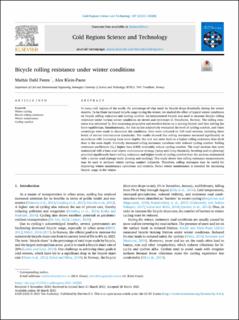| dc.contributor.author | Fenre, Mathis Dahl | |
| dc.contributor.author | Klein-Paste, Alex | |
| dc.date.accessioned | 2021-06-01T07:47:00Z | |
| dc.date.available | 2021-06-01T07:47:00Z | |
| dc.date.created | 2021-04-21T17:18:29Z | |
| dc.date.issued | 2021 | |
| dc.identifier.citation | Cold Regions Science and Technology. 2021, 187, 1-11. | en_US |
| dc.identifier.issn | 0165-232X | |
| dc.identifier.uri | https://hdl.handle.net/11250/2757143 | |
| dc.description.abstract | In many cold regions of the world, the percentage of trips made by bicycle drops drastically during the winter months. To facilitate increased bicycle usage during the winter, we studied the effect of typical winter conditions on bicycle rolling resistance and cycling comfort. An instrumented bicycle was used to measure bicycle rolling resistance under various winter conditions on streets and cycleways in Trondheim, Norway. The rolling resistance was estimated by first measuring propulsive and resistive forces on a moving bicycle and then solving the force equilibrium. Simultaneously, the test cyclist subjectively evaluated the level of cycling comfort, and video recordings were made to document the conditions. Data were collected on 103 road sections, including three levels of service (maintenance standards). The results showed that rolling resistance increased significantly in accordance with increasing loose snow depths. Dry and wet snow leads to a higher rolling resistance than slush does at the same depth. Similarly, increased rolling resistance correlates with reduced cycling comfort. Rolling resistance coefficients (Crr) higher than 0.025 noticeably reduce cycling comfort. The road sections that were maintained with a bare road winter maintenance strategy (using anti-icing chemicals, brushing and/or plowing) provided significantly lower rolling resistance and higher levels of cycling comfort than the sections maintained with a winter road strategy (only plowing and sanding). This study shows that rolling resistance measurements may be used to estimate winter cycling comfort indirectly. Therefore, rolling resistance may be useful for improving winter maintenance operations and controls. Better winter maintenance is essential for increasing bicycle usage in the winter. | en_US |
| dc.language.iso | eng | en_US |
| dc.publisher | Elsevier Science | en_US |
| dc.rights | Navngivelse 4.0 Internasjonal | * |
| dc.rights.uri | http://creativecommons.org/licenses/by/4.0/deed.no | * |
| dc.title | Bicycle rolling resistance under winter conditions | en_US |
| dc.type | Peer reviewed | en_US |
| dc.type | Journal article | en_US |
| dc.description.version | publishedVersion | en_US |
| dc.source.pagenumber | 1-11 | en_US |
| dc.source.volume | 187 | en_US |
| dc.source.journal | Cold Regions Science and Technology | en_US |
| dc.identifier.doi | 10.1016/j.coldregions.2021.103282 | |
| dc.identifier.cristin | 1905689 | |
| dc.description.localcode | This is an open access article distributed under the terms of the Creative Commons CC-BY license, which permits unrestricted use, distribution, and reproduction in any medium, provided the original work is properly cited. | en_US |
| dc.source.articlenumber | 103282 | en_US |
| cristin.ispublished | true | |
| cristin.fulltext | postprint | |
| cristin.fulltext | original | |
| cristin.qualitycode | 2 | |

